A show in Washington, D.C. suggests that tall buildings of the future can and should be built out of wood.
The exhibition is open at the National Building Museum.
Wood has been an important building material for homes and other structures in many areas since ancient times. Modern tall buildings, however, are made out of man-made products, such as steel, concrete and glass.
The exhibition is called “Timber City.” Timber is an expression for trees that are grown to produce wood.
“Timber City” shows the work of two winners of the Tall Wood Building Prize.
The award was the idea of industry groups and the United States Department of Agriculture. They hope to show new ways of manufacturing wood products for tall buildings -- structures with three or more floors.
The exhibition’s curator is Susan Piedmont-Palladino. She says the prize winners are responsible for building projects in two U.S. communities.
“One in New York City and one in Portland, Oregon, are two premier cross-laminated timber buildings going up right now.”
Piedmont-Palladino says the two buildings are similar in appearance and design. She says both use the same cross-laminated material. Cross-laminated material is made of several pieces of wood. The pieces are connected together at 90-degree angles. This is a way to make the finished wood product stronger.
Piedmont-Palladino says it is a good idea to use wood products manufactured in this way for areas like New York’s Manhattan. As a result, the building can be constructed quickly without affecting nearby homes and offices.
“Buildings go up very quickly. The materials for the building, the walls and the floors and the ceilings – are manufactured off-site.”
Piedmont-Palladino says the building materials arrive on a truck after being manufactured in another place. Workers using power tools can put the pieces together very quickly, she says.
And the wood does not bend very much. “It’s what we called dimensionally stable,” she adds.
Information on large wood panels shows the exhibit’s visitors reasons that building from wood is good for the environment.
One panel says that concrete, a common building material, has been linked to rising temperatures in Earth’s atmosphere. The sign says manufacturing concrete is the third largest producer of greenhouse gasses. Studies have linked those gases to the rise in temperatures.
Other information says harvesting wood has a lower environmental cost than manufacturing concrete because the materials do not need to be mined and processed.
Another reason to use wood in buildings might be that it improves the way people feel about the building.
Piedmont-Palladino notes that people say they like being surrounded or living in a home made of wood.
“And then there’s this concept of biophilia. That's the theory that we are attracted to and relaxed by, and in general our mental and physical health is improve by being in proximate condition to nature or to elements from nature.”
Wood cannot be used for all buildings, notes Piedmont-Palladino. It cannot be used in every situation. But she predicts there soon will be more structures made from manufactured wood products.
I’m Mario Ritter.
June Soh wrote this report for VOANews.com. Mario Ritter adapted her report for Learning English. George Grow was the editor.
We want to hear from you. Do you think using wood for construction is a good idea? Let us know in the comment section below.
______________________________________________________________
Words in This Story
exhibition – n. an event such as a show or demonstration of something such as artwork or other creative work
curator – n. a person who oversees objects in a museum, exhibit, etc.
premier – adj. important
construct – v. to build, to create
dimensionally stable – adj. something that does not change shape very much
proximate – adj. near, close





